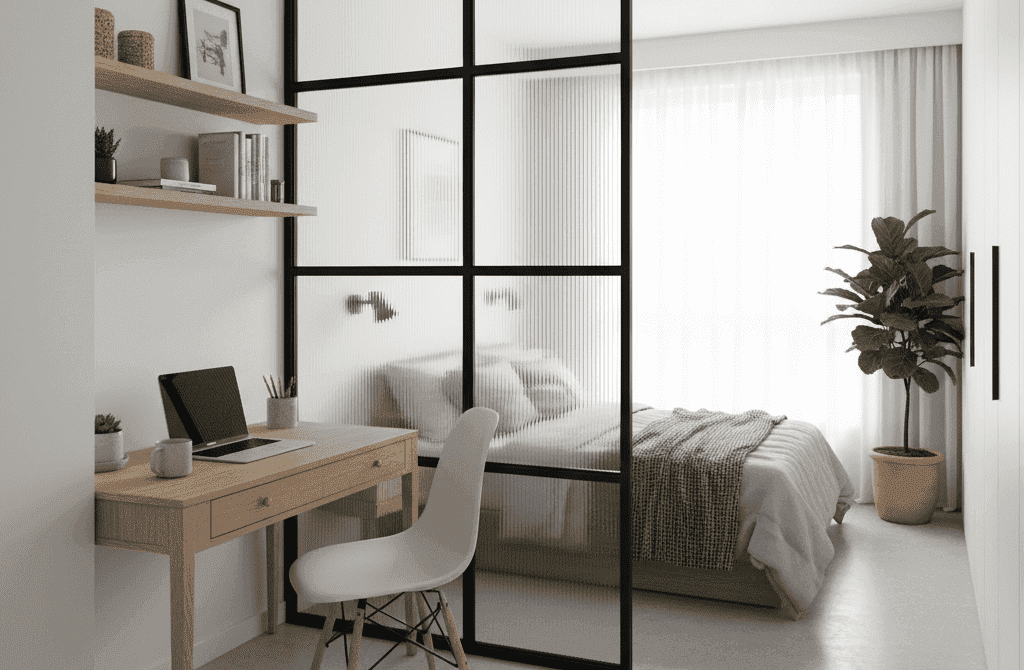7 Strong Ways to Design a Studio Workspace
You think living in a studio kills the dream of having a proper office? Nah. It’s about carving, layering, cheating a bit with perception. A small room can hold more worlds than you expect. The trick is not fighting the limits but folding them into the design.
I’ll sketch out approaches I’ve seen work—messy, some harsh, but honest. Then I’ll mix in what the big design brains are pushing out there. And in the middle of it, your daily life will actually start to breathe instead of collapse under clutter.
Quick Parameters (things to keep in mind)
- Space zoning matters more than square meters.
- Lighting changes mood instantly.
- Storage doubles as walls, walls double as storage.
- Don’t fear bold colors, they hide the mess.
- Scale contrast—tiny next to huge—adds depth.
- Furniture must do tricks, or it’s dead weight.
Why scale makes or breaks it
I’ve seen studios ruined by overcautious people: everything slim, polite, beige. It ends up flat, like a waiting room. Throw one big brutal table in there, suddenly the room has a spine. Same goes for art—curated art on the wall isn’t just decoration, it’s an anchor for the entire mood.
Scale isn’t about size alone—it’s about courage. A single oversized lamp hovering above a modest desk, or a giant framed print towering in a narrow hallway, reshapes how the space feels. Large objects introduce rhythm; they break the monotony of “tiny furniture for a tiny place.”
People think a small apartment needs only small furniture. That’s a trap. The eye craves hierarchy: big, medium, small. Without that, your studio becomes a flat collage where nothing stands out. A bold focal point acts like punctuation in a sentence—it lets the rest breathe.
If you can’t afford much, then pick one piece with real presence. The rest can fade away. That’s how a premium interior on a budget feels alive: mixing texture contrast with focal pieces instead of scattering weak decor everywhere. Better one big brutal table than five timid stools that whisper nothing.
Silence in chaos
Studios are noise traps. You need defense. Popular solutions? Soundproof curtains, heavy rugs, and—here comes the INSERT—popular solutions became soundproof glass partitions, allowing you to work in silence even in open layouts.
Noise is more than sound—it’s tension. The hum of the fridge, footsteps from above, neighbors arguing, even the keyboard clatter bouncing off bare walls. Without buffers, the room becomes hostile. Every studio dweller knows the feeling: trying to focus, but the space itself feels too thin to hold concentration.
This is where modern coworking design crosses into homes. Look at how coworking design uses flexible zones and acoustic pods. Translate the idea smaller: a folding screen, a mobile partition, even a bookshelf flipped into a wall. Doesn’t matter if it’s fancy—privacy is about psychology more than decibels.
Think of it as layering. A rug absorbs footsteps. Thick curtains soften echoes. A partition doesn’t just block sight—it signals to your brain: “this is the work zone.” Add plants, tall ones, to dampen high-frequency noise. Cluster soft objects—pillows, textiles, fabric panels—around your desk. Each tiny step cuts noise by 5%, but combined they change the entire emotional tone of the room.
Silence in a studio isn’t total. It’s relative. It’s about carving out a corner where your body finally relaxes, where concentration feels possible. That corner doesn’t need to be big—just defined, shielded, and yours.
Hide the chaos, don’t fight it
Hidden storage is a lifesaver. If you see cables, stacks, boxes every day, you’ll never believe you’re in control. Shove them out of sight. Pegboard systems, modular units, vertical solutions—these let your brain unclench.
The mistake is buying “more” storage instead of smarter storage. Tall vertical? Better. Multi-function bench? Great. Shallow drawer you forget exists? Waste. That’s why a home office thrives on simple tricks: hide, stack, repeat.
Borrow tricks from brutalism
This sounds nuts for a cozy studio, but brutalism can teach you discipline. Concrete surfaces, mirrors bouncing fragments of nature, raw surfaces that don’t hide. You don’t copy the style, you borrow the clarity: let one material dominate, let texture do the work. Suddenly you stop drowning in random finishes.
Check out brutalism and notice the lesson: power through simplicity. That’s survival in small rooms.
High-tech revival in miniature
Industrial vibes are back—pipes, exposed systems, metallic finishes. But shrink it. Instead of turning your ceiling into a factory, maybe expose one detail, polish a metal lamp, or run a visible cable tray neat enough to feel intentional.
That’s the essence of high-tech interiors: functionality as ornament. In a studio, one touch is enough.
The future whispers “sustainable”
Even in a one-room flat you can join the bigger shift. Common material frameworks, circular economy thinking, healthier paints and fabrics—they’re part of interior design’s sustainable push.
Choosing one durable table over three flimsy ones is part of it. Same with textiles—better to save and buy something that lasts a decade than fill the space with landfill fodder. That’s how a sustainable future in design sneaks into your own four walls.
Put it together (messy but true)
Your studio workspace isn’t about copying Pinterest boards. It’s about tricking the eye, silencing the noise, and letting the room multitask without screaming about it. Some days it will feel perfect, others too cramped. That’s fine. Spaces breathe like people do.

FAQs
Q: How do I separate work and rest in a studio?
A: You need clear markers. Options include:
- A sofa back facing the desk, making an invisible wall.
- Rugs with different textures, dividing sleep from work.
- Slim shelving that doubles as a screen.
- Portable partitions you fold away when guests arrive.
Even one bold divider creates two worlds inside a single room.
Q: What’s the cheapest way to improve my workspace?
A: Lighting. Always lighting. You can:
- Swap out harsh white bulbs for warm dimmable ones.
- Add a desk lamp that throws a cone of focus.
- Use LED strips under shelves—cheap but effective.
- Rely on one dramatic overhead fixture to shift mood.
It feels minor until you try it. Then it’s the difference between a dorm room and a working studio.
Q: Do small studios really benefit from bold colors?
A: Yes. Here’s why:
- Bold color blocks distract the eye from clutter.
- Darker hues push boundaries outward visually.
- Contrasts create depth, which is what small rooms lack.
- Color can define “zones” where no physical wall exists.
Pale beige, on the other hand, tends to amplify the mess.
Q: How do I make it feel bigger without adding space?
A: Trickery, pure and simple:
- Hang mirrors opposite windows—double the daylight.
- Use vertical storage, pulling the eye upward.
- Place one oversized object (table, artwork) to exaggerate scale.
- Keep sightlines open—no bulky furniture blocking the middle.
It’s not about actual square meters. It’s about how the brain perceives depth and light.
Q: How do I stop my workspace from feeling temporary?
A: Commit. Don’t treat it as “just the corner.” Give it weight.
- Put art or shelves behind the desk.
- Anchor it with a rug.
- Invest in one quality chair.
- Add plants that stay, not seasonal clutter.
If you respect the corner, the corner respects you back.
